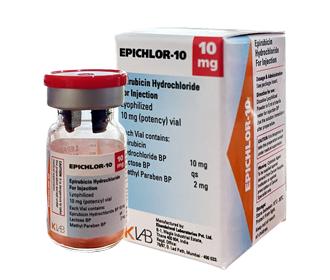
EPICHLOR 10 Powder for Injection (Lyophilized)
Therapeutic Class
Chemotherapeutic Drugs
Indications
Epirubicin HCL injection is indicated as a component of adjuvant therapy in patients with evidence of axillary node tumor involvement following resection of primary breast cancer.
Chemical Composition
Each vial contains Epirubicin Hydrochloride BP 10 mg
Packaging
1 vial / Box
Dosage & Administration
When Epirubicin is used as a single agent, tile recommended dosage in adults is 60-90 mg / m2 body area; the drug should be Injected I. V. over 3-5 minutes and depending on the patients haematomedullar status, the dose should be repeated at 21-day intervals. Lower doses (60-75 mg / m2) are recommended for the patients whose bone marrow function has already been impaired by the previous chemotherapy or radio-therapy, by age, or neoplastic bone-marrow infiltration. The total dose per cycle may be divided over 2-3 successive days. When the drug is used in combination with other antitumour agents, the doses need to be adequately reduced. Since the major route of elimination of Epirubicin is the hepatobiliary system, the dosage should be reduced in patients with impaired liver function, in order to avoid an increase of overall toxicity. Moderate liver impairment (bilirubin: 1.4-3 mg / 100ml, or BSP retention: 9-15%) requires a 50% reduction of dose while severe impairment (bilirubin>3 mg / 100 ml or BSP rention> 15%) necessitates a dose reduction of 75%. Moderate renal impairment does not appear to require a dose reduction in view of the limited amount of Epirubicin excreted by this route.
Contraindications
Patients should not be treated with Epirubicin HCI injection if they have any of the following conditions; Baseline neutrophil count < 1500 cells/mm2, severe myocardial insufficiency, recent myocardial infarction, severe arrhythmias; previous treatment with anthracyclines up to the maximum cumulative dose; hypersensitivity to epirubicin, other anthracyclines, or anthracenediones; or severe hepatic dysfunction.
Side Effects
Apart from myelosuppression and cardiotoxicity (described under precautions the following adverse reactions have been described). -Alopecia, normally reversible, appears in 60-90% of treated cases; it is accompanied by the lack of beard growth in males; -Mucositis may appear 5-10 days after the start of treatment and usually involves stomatitis with areas of painful erosions, mainly along the sides of the tongue and on the sublingual mucosa; -Gastro-intestinal disturbances, such as nausea, vomiting and diarthoea; -Hyperpyrexia.

